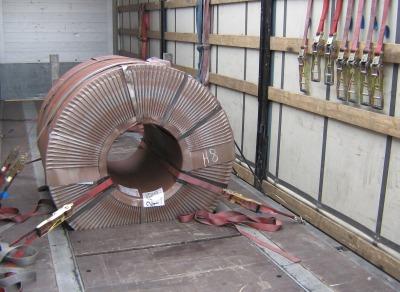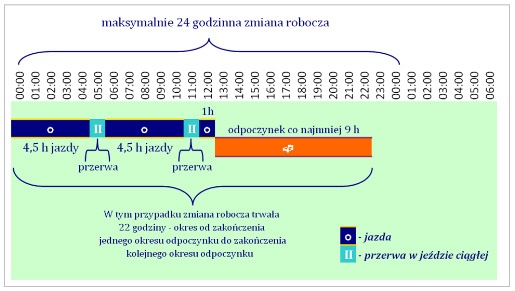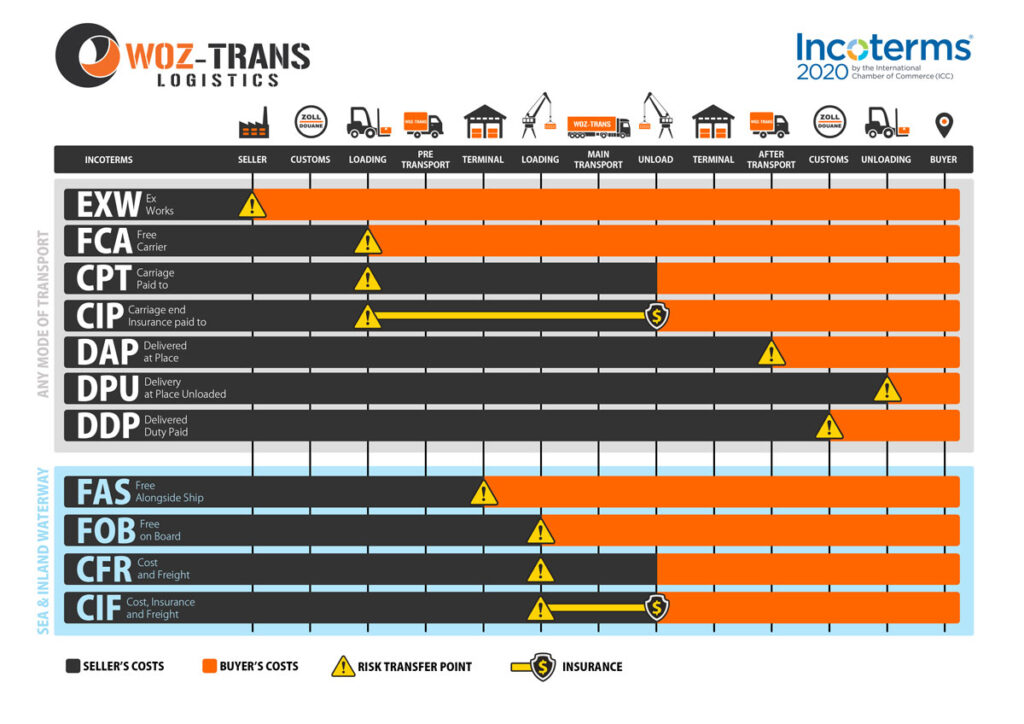Glossary
In this section, we have compiled a glossary of transportation terminology to familiarize you with the operations and specifics of the TSL (Transport, Spedition, Logistics) industry. We will also feature answers to the most frequently asked questions directed to our freight forwarders.
Search:
-
Incoterms
An international set of rules defining the terms of a contract of sale between a seller and a buyer. They allocate costs and responsibilities between the parties, specify the agreed mode of transport, and define the point of risk transfer for the goods from the seller to the buyer.
Go to the Incoterms Knowledge Compendium
-
ADR
An acronym for the French “L’ Accord européen relatif au transport international des marchandises Dangereuses par Route”. A colloquial term for dangerous goods, as well as the name of the international convention regulating the carriage of this type of cargo. Detailed information and the legal acts governing this type of transport can be found on the website of the Ministry of Infrastructure and Development. -
Notification (Pre-advice)
A notification sent to the consignee confirming the dispatch of goods. In freight forwarding terminology, a notification (or pre-advice) is the process of advising the carrier or warehouse of the planned loading or unloading of goods at a specific time, effectively scheduling a time slot for the operation. -
Bordero
A supplementary document used in road transport, mainly in the context of groupage or LTL freight. It specifies the distribution instructions for the individual consignments within a consolidated shipment. The document accompanies copies of the main transport document (consignment note) and is issued by the consignor. -
C-Commerce (Collaborative Commerce)
A business model in e-commerce designed to facilitate collaborative interactions among employees, as well as between distinct business partner enterprises. In practice, this involves fostering interdependencies among business partners with the aim of optimizing all commercial processes. -
CEPIK
The Information System of the Central Register of Vehicles and Drivers, which contains information on vehicles registered in Poland and drivers holding Polish driving licenses. The CEPIK IT System comprises two registers: the Central Register of Vehicles (CEP) and the Central Register of Drivers (CEK). The Central Register of Vehicles collects data on vehicles registered in Poland. -
Refrigerated Vehicle / Reefer
A cargo body designed for the transport of goods that require a specific, controlled temperature environment. Refrigerated vehicles are equipped with a refrigeration unit to ensure and maintain the prescribed temperature throughout transit. -
Coil Well Trailer (Coilmulde)
A semi-trailer adapted for the transport of cargo in the form of coils. The coils are placed in a trough-like recess, known as a coil well, which runs along the longitudinal axis of the vehicle floor.

-
Cross-trade
The execution of transport services between two countries by a carrier whose registered office is located in a third country (i.e., outside both the country of loading and the country of unloading). -
Drivers’ Hours of Service
The total regulated driving time. A driver is required to take a mandatory 45-minute break after 4.5 hours of driving. Following the break, the driver may resume driving for another 4.5-hour period, which must be followed by a daily rest period of typically 11 hours. This rest period can be reduced to 9 hours up to three times a week. The maximum daily working period (spread), covering all activities within a shift, cannot exceed 15 hours.

-
Curtainsider
A truck, semi-trailer, or trailer with a body construction similar to a tilt trailer. The fundamental difference is its adaptation for side loading and unloading, made possible by its sliding side curtains. -
Fixed Appointment (FIX)
A term in the transport industry signifying that the goods must be delivered to the consignee at a precisely agreed date and time. Early or late arrivals are not permitted. Failure by the carrier to adhere to this strict deadline may result in various consequences, such as waiting for the next available delivery slot (which may take several days), the imposition of contractual penalties, and costs associated with the delivery failure, including potential production line stoppages or factory downtime. -
FTL (Full Truckload)
An acronym for “Full Truckload,” denoting a mode of transport where a shipment occupies the entire capacity of a truck. The client may also utilize a portion of the vehicle (Partial Truckload or PTL) or reserve the entire cargo space for exclusive use, meaning no other goods are co-loaded. This dedicated service is crucial for time-sensitive deliveries or for the transport of sensitive or high-value cargo. -
Transport Disposition
The contractually defined right and obligation to organize the transport and cover its costs. This disposition is determined in advance by the trading partners (the buyer and the seller), typically during contract negotiations. The mutual agreement specifies which party assumes responsibility for managing the transport. The subsequent transport order details who is responsible for selecting the mode of transport, the route, and the schedules for collection and delivery. -
Freight Integrator
An entity responsible for logistics management focused on the consolidation of shipments. It addresses the comprehensive scope of freight consolidation, incorporating all modes of transport. -
Just-in-Time
A supply chain strategy focused on timely delivery and transport planning to eliminate idle time. Its primary objective is to optimize production costs by minimizing or eliminating inventory holding expenses. This methodology also aims to enhance labor utilization, streamline information flow, increase overall productivity, and consequently reduce the risk of product obsolescence or damage. -
Cabotage / Cabotage Transport
The national transport of goods for hire or reward carried out by a non-resident carrier within a host country. This operation, which can be performed by various modes of transport (road, rail, air), involves both loading and unloading taking place within the territory of the same country. For example, a transport operation from Hamburg to Berlin performed by a carrier registered in Poland constitutes cabotage in Germany. -
Edge Protectors
Also known as corner protectors, they are used to protect lashing straps. Made from durable materials and applied at points where a strap interfaces with the cargo, they prevent abrasion and wear. The contact surface area of the protector is significantly larger than that of the strap alone, which distributes the clamping force over a wider area. Therefore, edge protectors safeguard not only the strap from premature failure but also the cargo from damage, enhancing overall transport safety. -
Stanchion
A vertical steel post that forms part of a trailer’s superstructure It is designed to hold transverse supports, such as sideboards or slats, typically made of wood or aluminum. -
Traffic Congestion
A state of excessive traffic volume or density on the road network, leading to severe delays or gridlock, colloquially known as ‘traffic paralysis’. It is typically caused by bottlenecks or blockages on specific road sections. -
Truck and Trailer Combination
A rigid truck with a drawbar trailer, offering a total loading length that exceeds 13.6 m. -
QR
From English, Quick Response. A graphical code used primarily for the rapid identification of actual demand for the final product, which is signaled during subsequent deliveries of goods. The system’s fundamental principle is based on a partnership among all links in the supply chain; in short, each link bears specific responsibilities. -
Walking Floor
Semi-trailer equipment that moves goods in both directions to facilitate loading and unloading. A walking floor automates and simplifies the loading and unloading of palletized goods, eliminating the need for a forklift or personnel to enter the trailer. This system enables very short unloading times of up to 10 minutes, depending on the goods being transported. -
Unloading
The process of unloading the goods/cargo upon arrival at the destination. -
Freight Forwarding
A service involving the organization of the transport of goods, as well as certain related services. Based on its scope, forwarding is divided into domestic, international, public (for third parties), and private (in-house). By mode of transport, it is classified as rail, air, sea, and road forwarding. Freight forwarding covers all activities related to organizing safe, cost-optimized, and on-time transport. However, it does not cover the physical transportation process itself. A contract of forwarding is not the same as a contract of carriage. -
Tachograph
A device typically installed in buses and trucks that registers, as a function of time: the distance traveled by the vehicle, its current speed, and the driver’s activity—i.e., their periods of work and rest (the so-called “rest period”). Currently, digital tachographs, which record data in their internal memory, are the most commonly used. -
Neutral Goods
Goods that do not require specialized trailer equipment or special driver training, and do not fall under the category of dangerous goods (ADR). Examples of neutral goods include: palletized automotive parts, building materials, and paper. -
Intermodal Transport
Transport that combines different modes of transport, such as road and rail or road and sea. Its purpose is to optimize transport costs. -
Tail Lift
A component of a truck’s equipment, mounted at the rear, to assist in the loading and unloading of goods. It is operated from the driver’s cab or by controls on the lift itself. -
Forklift Truck
Also known as a lift truck. It is a powered mechanical vehicle used primarily for transporting heavy materials (up to several tens of tons). It is mainly used for unloading operations in factories, ports, and warehouses. Goods are typically transported on wooden pallets. Only authorized personnel are permitted to operate a forklift truck. -
Thermograph Printout
An electronic system for monitoring and recording the temperature of transported goods. Vehicles designed for the carriage of frozen or chilled food products (refrigerated vehicles/reefers) are equipped with thermographs. The thermograph printout enables easy verification of the goods’ temperature during both loading and unloading. -
Loading
The process of placing goods/cargo onto a transport vehicle. Depending on the vehicle type, loading can be performed from the side, rear, or from the top using a crane. -
Side/Rear/Top Loading
Depending on the vehicle type, various loading methods are available: For refrigerated vehicles (reefers), only rear loading is possible. Walking Floor – facilitates easy top loading, typically for bulk materials (side and rear loading are also possible). Box Body (rigid body) – loading is exclusively from the rear. Curtainsider/Tautliner – one of the most common semi-trailer types; allows for side, top, and rear loading. Rear loading is also frequently performed using a loading ramp or a tail lift. Top loading is most commonly performed using a crane. -
LTL
An acronym for “Less Than Truckload,” referring to partial truckload or groupage shipments. This shipping service implies that a single consignment does not occupy the full available cargo space of a vehicle. The transport route typically features multiple loading and unloading points, and transshipments to other vehicles may be carried out for route and cost optimization. While delivery lead times are extended, pricing is more attractive for clients. It must be noted that due to weight and dimensional constraints, not all goods qualify for LTL transport, even if they do not fill the entire cargo space. -
EURO Pallet
A structure made of wood or other materials, designed for the transportation and storage of goods. EURO pallets have standard dimensions of 120 x 80 cm. A EURO pallet is marked on the side with the ‘EUR’ designation. -
Industrial Pallets
With dimensions of 120 cm x 100 cm. They are primarily used as an alternative to EURO pallets (120×80 cm) for the distribution of heavy products. They possess a higher load-bearing capacity than EURO pallets. -
Oversize/Abnormal Load
Transport of cargo that, by virtue of its mass and/or dimensions, exceeds the standard legal limits for transit on public roads—also referred to as non-standard or abnormal transport. The execution of such transport demands meticulous organization, specialized equipment, and an experienced crew. It also frequently requires the deployment of an escort vehicle (or ‘pilot’), which alerts other road users to the transport operation and ensures overall safety. -
External Costs of Transport
All costs related to the provision of a transport service that are not borne by the service provider or the client. These externalities include costs associated with the negative impact of transport on the natural environment and human society. -
Lashing Chains
Used to secure heavy cargo onto vehicles. They prevent the transported load from shifting during transit. -
Friction Mats (Anti-Slip Mats)
Manufactured from rubber granulate, these mats serve as an additional component for load securement, preventing cargo displacement. They are frequently used in combination with lashing straps. The primary function of friction mats is to increase the coefficient of friction, thereby preventing the goods from sliding on the loading surface. -
Mega Trailer
A versatile vehicle that excels at standard tasks, it is also indispensable for high-volume transport. Known as Mega trailers, these are semi-trailers with a lowered floor, which allows for an internal loading height of three meters. This design feature makes these semi-trailers suitable for transporting both conventional cargo and high-cube goods. -
CMR International Consignment Note
From the French Convention relative au contrat de transport international de Marchandise par Route, this is the standard document for international road freight. It serves as evidence of the contract of carriage and contains essential information, including: places of loading and unloading; a description of the goods (quantity, weight); details of the parties to the carriage; dispatch and delivery dates; agreed transport costs; special instructions (e.g., for customs clearance); and a list of documents handed to the driver. -
MiLoG
The German Minimum Wage Act (Mindestlohngesetz), which introduced a minimum wage of €8.50 per hour for work performed in Germany, also applies to foreign employees, including Polish drivers. According to the Act, the minimum wage must be paid to non-German nationals working in Germany, even if they are employed by a company based in another country and are working temporarily in Germany. This requirement covers cabotage operations, international transport with loading or unloading in Germany, and transit through Germany. Employers found in violation of these regulations are subject to fines of up to €30,000. -
Toll
A fee charged for the use of a road, motorway, bridge, or tunnel. -
Neutralization
A procedure ensuring the anonymity of the original shipper and the final consignee. The shipper is not informed of the final destination, while the consignee is unaware of the original shipper’s identity. The driver issues separate CMR consignment notes as instructed by the contracting party (e.g., the freight forwarder). -
Carrier’s Liability Insurance
Insurance covering the carrier’s liability for operations in both domestic and international transport. -
Personal Protective Equipment (PPE)
Equipment worn to protect the user against health and safety risks. PPE is frequently mandatory during loading and unloading operations. Standard required items typically include: gloves, a safety helmet, safety footwear, safety glasses, and a high-visibility vest. -
Polish General Forwarding Rules (OPWS)
A set of general conditions for freight forwarders developed by the Polish Chamber of Forwarding and Logistics (PISIL), consisting of 31 articles. The OPWS define the rights and obligations of the parties to a forwarding contract; however, they are not statutory provisions and do not constitute a source of law. They are applied to the contractual relationship between the freight forwarder and their principal. If a substitute forwarder is engaged, these conditions also apply to them and govern their relationship with the commissioning party. The OPWS contain key definitions, general provisions, the duties of the forwarder in providing forwarding services and concluding contracts, and regulate the scope of the forwarder’s liability for loss or damage arising from the organization of the carriage of goods. The provisions of the OPWS do not apply to the forwarding of money, works of art, or human remains. -
Exchangeable / Non-Exchangeable Pallets
Pallet circulation in transport operates under two primary systems:
Non-Exchangeable Pallets: The carrier is not required to transport empty pallets. Goods are palletized at the loading point and the pallets are delivered with the consignment to the destination, without any exchange taking place.
Exchangeable Pallets: The carrier transports empty pallets for exchange, typically stowed in a pallet carrier. At the loading point, the driver exchanges empty pallets on a one-for-one basis for the loaded pallets. Upon unloading, the driver receives an equivalent number of empty pallets in return. These transactions are formally recorded in the transport documentation (pallet notes). -
Lashing Straps
Equipment used for load securing, primarily to restrain cargo during transport. The function of lashing straps is to counteract the dynamic forces acting upon the load during transit, thereby preventing cargo shifting and mitigating potential damage or loss. When selecting straps, it is crucial to ensure they are free from damage and have a clearly legible identification label. -
Curtain Sider / Tautliner
A type of semi-trailer or trailer where the cargo space is enclosed by a tarpaulin supported on a superstructure. This cover protects the cargo from atmospheric conditions and forms the sides and roof of the load space.
